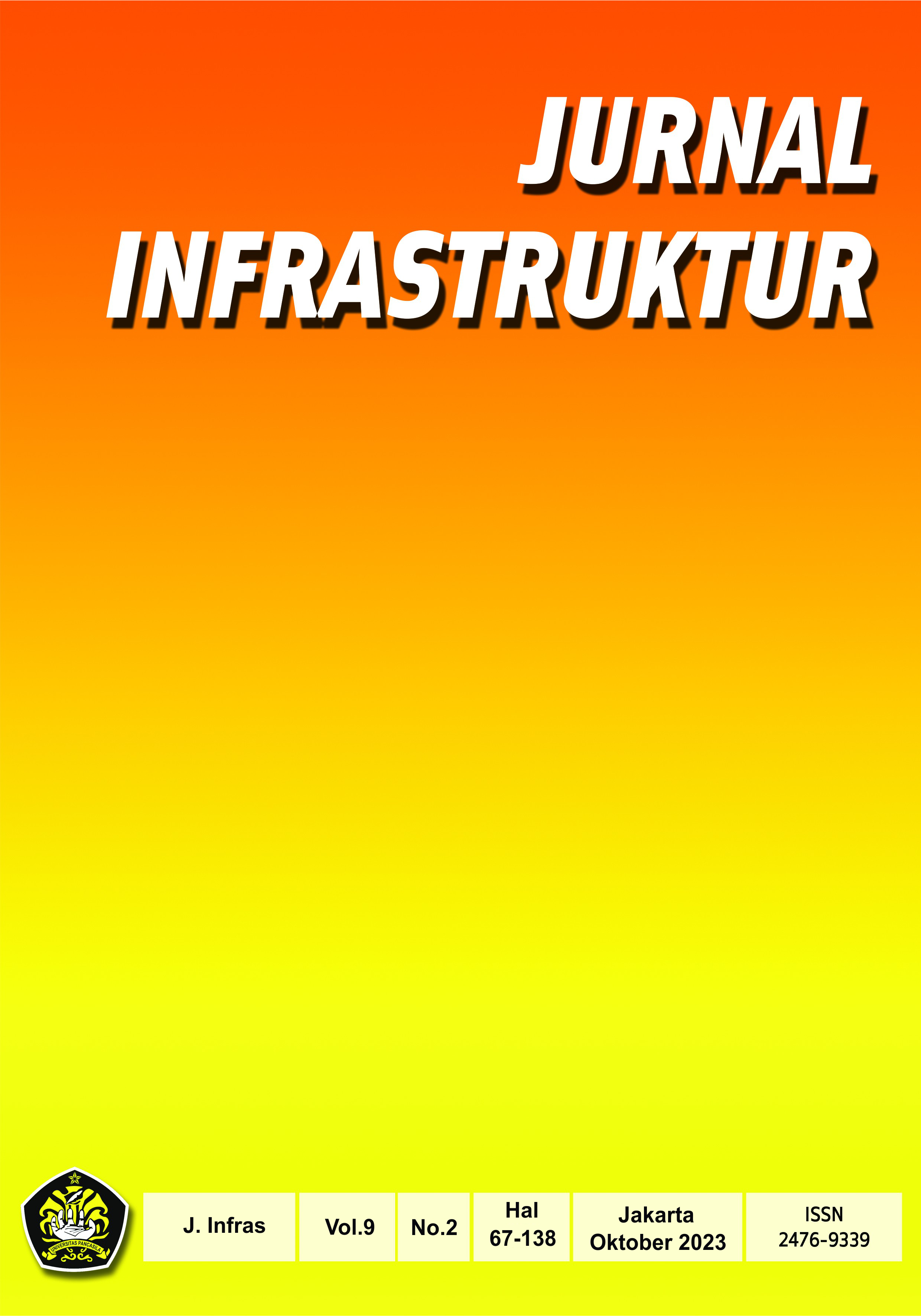THE INFLUENCE OF ASPECT RATIO OF REBAR-WIRE FIBER ON RHEOLOGICAL AND MECHANICAL PROPERTIES OF SELF CONSOLIDATING CONCRETE
Abstract views: 156 | pdf downloads: 139
Abstract
It is often observed that compacting device is not applied optimally when faced with difficult placement situations and self-compacting concrete is as one of solution. The production of the concrete is carried out by optimizing aggregate size and proportion as well as certain amount of superplasticizer. In order to improve tensile strength of concrete, then local rebar wire fiber, widely known in Indonesia as Bendrat, can be involved to the fresh concrete, however workability of Self-compacting concrete will be reduced as the aspect ratio of rebar wire fiber increases. This research is intended to discover the effect of aspect ratio of local rebar wire fiber on the mechanical properties of Normal Strength Self compacting concrete. Concrete samples used in this study are 150x300mm concrete cylinder made according to EFNARC recommendation. The diameter of rebar-wire fiber is kept constant namely 0.7mm whereas the aspect ratio varies between 60-100. Compressive strength, Splitting tensile strength and Flexural strength of Self-compacting concrete is obtained by testing of concrete samples according to SNI 1974:2011, SNI 2491:2014 and SNI 4431:2011 respectively. The results showed that Rheological properties of fresh concrete and mechanical properties of self-compacting concrete are highly influenced by aspect ratio of rebar wire fiber. Rheological properties, such as Flowability, Passing ability and Segregation resistance decreases as the aspect ratio increases. Moreover, the research result indicate that Compressive strength of self-compacting concrete is insignificantly improved as the Aspect rasio increase. Optimum compressive strength is obtained from concrete specimens with aspect rasio of 70. On the other hand, the addition of rebar wire fiber on the fresh concrete significantly govern the properties of Tensile strength of self-compacting concrete with the optimum aspect rasio ranging from 70-80.
References
ASTM C127-07, Standard Test Method for Density, Relative Density (Specific Gravity), and Absorption of Coarse Aggregate, (Annual Book of ASTM Standard Vol. 04.02)
ASTM C128-07a, Standard Test Method for Density, Relative Density (Specific Gravity), and Absorption of Fine Aggregate, (Annual Book of ASTM Standard Vol. 04.02)
ASTM C136/C136M-14, Standard Test Method for Sieve Analysis of Fine and Coarse Aggregates, (Annual Book of ASTM Standard Vol. 04.02)
Buana, F., Gunawan, I. (2016), Pengaruh Diameter Serat Polymer Etilene Braid Terhadap Kuat Tekan Dan Kuat Tarik Belah Pada Beton Mutu Tinggi, Jurnal Fropil Vol 4 Nomor 2 Juli-Des 2016
Cui, T., Kulasegaram, S., Li, H. (2023), Prediction of Mechanical Properties of Steel Fibre-Reinforced Self-compacting Concrete by Machine Learning Algorithms. In: Jędrzejewska, A., Kanavaris, F., Azenha, M., Benboudjema, F., Schlicke, D. (eds) International RILEM Conference on Synergising Expertise towards Sustainability and Robustness of Cement-based Materials and Concrete Structures. SynerCrete 2023, RILEM Bookseries, vol 44. Springer, Cham. https://doi.org/10.1007/978-3-031-33187-9_65
EFNARC, (2002), Specification & Guidelines for Self-Compacting Concrete, English ed., Norfolk UK: European Federation for Specialist Construction Chemicals and Concrete Systems
EFNARC, (2005), The European Guidelines for Self-Compacting Concrete Specification, Production and Use, Norfolk UK: European Federation for Specialist Construction Chemicals and Concrete Systems.
Hamdi, Dafrimon, Harijadi, S., Revias, (2019), Pengaruh Penambahan Kawat Bendrat Galvanis Pada Campuran Beton Terhadap Kuat Lentur beton, Jurnal Deformasi Vol. 4 No. 1 Pp. 31-44
Malino, L., Wallah, S. E. dan Handono, B.D., (2019), Pemeriksaan Kuat Tekan Dan Kuat Tarik Lentur Betonserat Kawat Bendrat Yang Ditekuk Dengan Variasi Sudut Berbeda, Jurnal Sipil Statik Vol.7 No.6, (711-722)
Okamura, H. and Ozawa, K., (1994), Self-Compacting High-Performance Concrete in Japan, ACI SP-159: International Workshop on High Performance Concrete, Michigan
Ramkumar K.B., Kannan Rajkumar P.R., Gunasekaran K., (2023), Performance of hybrid steel fiber-reinforced self-compacting concrete RC beam under flexure, Engineering Science and Technology, an International Journal, Volume 42,2023,https://doi.org/10.1016/j.jestch.2023.101432, (https://www.sciencedirect.com/science/article/pii/S2215098623001106)
SNI 4431:2011, Cara Uji Kuat Lentur Beton Normal dengan Dua Titik Pembebanan, ICS 91.100.30, Badan Standarisasi Nasional, BSN 2011
SNI 2491:2014, Metode Uji Kekuatan Tarik Belah Spesimen Beton Silinder, ICS 91.100.30, Badan Standarisasi Nasional, BSN 2014
SNI 1974:2011, Cara Uji Kuat Tekan Beton Dengan Benda Uji Silinder, ICS 91.100.30, Badan Standarisasi Nasional, BSN 2011
Copyright (c) 2023 Jurnal Infrastruktur

This work is licensed under a Creative Commons Attribution-NonCommercial-ShareAlike 4.0 International License.














